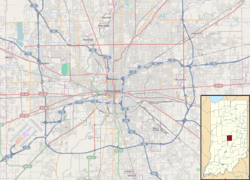Herron–Morton Place Historic District
Herron–Morton Place is a historic district in Indianapolis, Indiana, dedicated to restoration and renewal. The boundaries of the neighborhood are East 16th Street on the south, East 22nd Street on the north, the alley west of North Pennsylvania on the west, and Central Avenue on the east.
Herron–Morton Place Historic District | |
 Talbott Street in the southwestern part of the district | |
   | |
| Location | Roughly bounded by Central Ave., 16th, Pennsylvania, and 22nd Sts., Indianapolis, Indiana |
|---|---|
| Coordinates | 39°47′34″N 86°9′9″W |
| Area | 147 acres (59 ha) |
| Built | 1822 |
| Architect | Multiple |
| Architectural style | Classical Revival, Queen Anne, Tudor Revival |
| NRHP reference No. | 83000131[1] |
| Added to NRHP | June 16, 1983 |
History
19th century
In 1859, the state purchased the land, which was still largely undeveloped, as a home for the Indiana State Fair.
At the start of the American Civil War, the area was used first as an induction center for the Indiana Volunteer Infantry, and later as the prisoner of war camp for Confederates, Camp Morton. After the Civil War, Indiana reclaimed the land to use as fairgrounds.
The area was then platted for residential development in 1890 and the city's elite began building elaborate homes in the area soon after.
20th century
At the beginning of the 20th century, the district directly north of 16th Street was one of Indianapolis’ most elegant residential neighborhoods. Morton Place, named for Indiana governor Oliver Morton, was home to many celebrated politicians, physicians, business leaders, and artists.
Indiana Impressionist artists T.C. Steele and William Forsyth founded their famed Hoosier Group art school in Morton Place in 1888. In 1895 John Herron's bequest founded the John Herron Art Institute, and funded new construction of a new main building and an art museum in Morton Place. The Herron Museum later became the Indianapolis Museum of Art.
The Morton Place neighborhood thrived until the Great Depression in the 1930s. Throughout the 1930s and World War II, many houses were subdivided into apartments. In the 1950s through 1970s many houses were lost to fire or demolition.
In 1983, Herron–Morton Place Historic District was listed on the National Register of Historic Places and became a historic preservation district in 1986. It encompasses 574 contributing buildings an representative examples of Classical Revival, Queen Anne, and Tudor Revival style architecture.[2]
21st century
The present day Herron School of Art and Design, the preeminent art school in Indiana, relocated to new buildings on the Indiana University-Purdue University Indianapolis campus in 2000 and 2005.
The original Herron School of Art buildings now house Herron High School, a classical liberal arts charter high school. They are historic district contributing properties to the HMPHD.
The Willard and Josephine Hubbard House was individually listed on the National Register of Historic Places in 2016.[3]
Community
Since 1950, Herron–Morton Place has hosted the Talbot Street Art Fair, an annual juried art fair held on Talbott Street in June of each year. The Herron–Morton Place Neighborhood Association was formed in 1976 to spearhead the renovation of home, encourage new residential development, reduce crime, and rebuild community spirit.
The Herron–Morton Place Neighborhood Foundation raises funds to maintain a historic neighborhood park (located on the 1900 block of Alabama Street) and other beautification efforts throughout the neighborhood. The Foundation plans several events each year that raise money for the neighborhood park, most notable are the annual Oktoberfest in late September and bi-annual home tour and Rock 'N' Romp a yearly event for families.
References
- "National Register Information System". National Register of Historic Places. National Park Service. March 13, 2009.
- "Indiana State Historic Architectural and Archaeological Research Database (SHAARD)" (Searchable database). Department of Natural Resources, Division of Historic Preservation and Archaeology. Retrieved 2016-08-01. Note: This includes Alan Goebes (February 1983). "National Register of Historic Places Inventory Nomination Form: Herron–Morton Place Historic District" (PDF). Retrieved 2016-08-01. and Accompanying photographs
- "National Register of Historic Places Listings". Weekly List of Actions Taken on Properties: 6/06/16 through 6/10/16. National Park Service. 2016-06-17.

